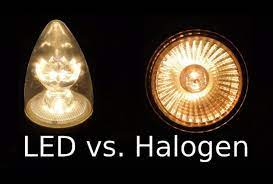In the world of lighting technology, the transition from traditional halogen bulbs to advanced LED lighting has brought about a remarkable revolution. As energy efficiency and sustainability take centre stage, it's becoming increasingly evident that LED lighting outshines halogen bulbs in more ways than one. In this article, we'll explore the compelling reasons why using LED lighting is a superior choice compared to halogen bulbs, from energy efficiency and longevity to environmental impact and design flexibility.
Energy Efficiency: Illuminating the Green Path
One of the most significant advantages of LED lighting over halogen bulbs is its unparalleled energy efficiency. LED (Light Emitting Diode) technology converts a higher percentage of energy into visible light, minimising wastage through heat generation. On the other hand, halogen bulbs operate by heating a filament until it emits light, resulting in substantial energy loss due to heat dispersion. LEDs consume up to 80% less energy than halogen bulbs to produce the same level of brightness, leading to substantial reductions in electricity bills and environmental impact
Longevity: Lighting the Way for Durability
When it comes to longevity, LED lighting boasts a remarkable advantage. LED bulbs have an average lifespan that is significantly longer than halogen bulbs, making them a cost-effective and low-maintenance lighting solution. While halogen bulbs typically last around 2,000 to 5,000 hours, LED bulbs can shine brightly for up to 25,000 hours or more, reducing the frequency of replacements and saving resources in the long run.
Environmental Impact: A Greener Glow
LED lighting contributes to a greener environment in multiple ways. By consuming less energy and producing minimal heat, LEDs help lower carbon emissions and decrease the overall demand for electricity. Additionally, LED bulbs are free from toxic elements like mercury, which is commonly found in fluorescent and compact fluorescent lamps (CFLs). This not only makes LED lighting safer for disposal but also reduces the risk of environmental contamination.
Heat Emission: A Cool Choice
Halogen bulbs are notorious for emitting a significant amount of heat while operating, leading to discomfort and potential safety hazards. In contrast, LED lighting remains cool to the touch, making it a safer and more comfortable option, especially in applications where close proximity to the light source is required. This feature makes LEDs ideal for display lighting, under-cabinet lighting, and other settings where heat-sensitive materials or objects are present.
Design Flexibility: Lighting the Canvas of Creativity
LED technology offers unparalleled design flexibility, allowing for innovative lighting solutions that enhance aesthetics and ambience. LEDs are available in a wide range of colours and can be easily dimmed or controlled to create dynamic lighting effects. This versatility opens the door to creative applications in architectural lighting, interior design, and even stage lighting. Halogen bulbs, on the other hand, are limited in design possibilities and often require additional equipment for dimming or colour adjustment.
Instant Lighting: Shining Bright from the Start
When you flick the switch, LED lighting instantly reaches full brightness, providing immediate illumination. Halogen bulbs, on the other hand, require a warm-up period to reach their maximum brightness, which can be inconvenient in situations where instant lighting is essential. Whether it's for security lighting or enhancing the ambience of a space, LED's instant brightness ensures that you're never left in the dark.
Directional Lighting: A Spotlight on Precision
LED lighting excels in providing directional illumination, making it an excellent choice for focused lighting applications. The directional nature of LEDs ensures that light is emitted precisely where it's needed, minimising light spillage and maximising efficiency. This is particularly valuable for tasks such as reading, accent lighting, and spot lighting, where concentrated illumination is crucial.
In Summary
The transition from halogen bulbs to LED lighting represents a significant leap forward in lighting technology, offering a plethora of advantages that extend far beyond conventional illumination. From energy efficiency and longevity to design flexibility and environmental impact, LED lighting outshines halogen bulbs on multiple fronts. As the world continues its journey towards a more sustainable and energy-efficient future, embracing LED technology is a bright and logical choice that brings numerous benefits to both individuals and the planet at large. So, whether you're upgrading your home lighting or considering commercial lighting solutions, LED is undoubtedly the radiant path to a brighter and greener future.

